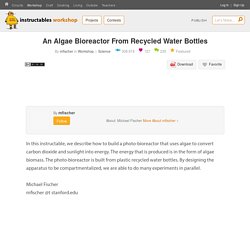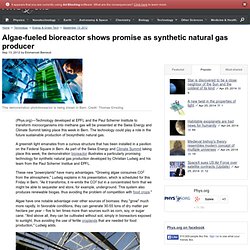

An Algae Bioreactor from Recycled Water Bottles. In this instructable, we describe how to build a photo-bioreactor that uses algae to convert carbon dioxide and sunlight into energy.

The energy that is produced is in the form of algae biomass. The photo-bioreactor is built from plastic recycled water bottles. By designing the apparatus to be compartmentalized, we are able to do many experiments in parallel. Michael Fischermfischer @t stanford.edu By using algae as a biofuel, we can increase the world's supply of oil while at the same time we decrease the amount of atmospheric carbon dioxide used during its production.
Portail:Phycologie. Energie par micro-algues. ♥ Des microalgues qui produisent des biocarburants et purifient l’eau. Mexique / / Amérique du nord Déjà très appréciées des industriels pour la fabrication de biogazole, les microalgues trouvent des applications dans de nombreux domaines.

De nouvelles technologies permettent de combiner une production intensive de biomasse à un assainissement extrêmement efficace de l’eau. Deux jours de culture Parmi les divers procédés utilisés pour produire des biocarburants, la culture des algues présente l’avantage majeur de ne pas empiéter sur les terres agricoles et d’offrir des rendements exceptionnels tout au long de l’année. Mais ce n’est pas la seule raison qui a poussé l’entreprise BioLets à s’intéresser aux microalgues.
La multiplication exponentielle des microalgues est réalisée dans des enceintes particulières, baptisées photoréacteurs à flux continu. Micro-algues et champignons. Algocarburant. Un article de Wikipédia, l'encyclopédie libre. schéma de production d'algocarburant Un algocarburant est un carburant à base de lipides extraits des micro-algues.

Les algocarburants sont des biocarburants de « troisième génération » potentiellement capables de remplacer les controversés biodiesels de « première génération », obtenus à partir d'huile végétale de plantes terrestres. Histoire[modifier | modifier le code] Le précurseur de l'utilisation des algues à l'échelle industrielle est Alexandre Saint-Yves d'Alveydre à la fin du XIXe siècle. Principales caractéristiques[modifier | modifier le code] Les algues sont le premier composant du kérogène, duquel est issu le pétrole[1]. Photosynthèse des microalgues[modifier | modifier le code] Principe de la production de carburants par des microalgues Les diatomées et les chlorophycées ont un processus photosynthétique similaire à celui des plantes supérieures. Rendements[modifier | modifier le code] Il existe différents types de rendements.
Growing Algae for Biodiesel Use" So, we've talked about the chemical process that takes algae and turns it into biodiesel fuel.

The real question, and one which many companies all over the globe are trying to answer, is how can we produce enough to meet the demand for biodiesel? The most natural method of growing algae for biodiesel production is through open-pond growing. Using open ponds, we can grow algae in hot, sunny areas of the world to get maximum production.
While this is the least invasive of all the growing techniques, it has some drawbacks. Bad weather can stunt algae growth, as can contamination from strains of bacteria or other outside organisms. Vertical growth/closed loop production has been developed by biofuel companies to produce algae faster and more efficiently than open pond growth. Other companies working to produce algae for biodiesel are constructing closed-tank bioreactor plants to help increase oil rates even further. Let's learn more about the pros and cons of algae biodiesel. Algae-fueled bioreactor shows promise as synthetic natural gas producer. (Phys.org)—Technology developed at EPFL and the Paul Scherrer Institute to transform microorganisms into methane gas will be presented at the Swiss Energy and Climate Summit taking place this week in Bern.

The technology could play a role in the future sustainable production of biosynthetic natural gas. A greenish light emanates from a curious structure that has been installed in a pavilion on the Federal Square in Bern. As part of the Swiss Energy and Climate Summit taking place this week, the demonstration bioreactor illustrates a particularly promising technology for synthetic natural gas production developed by Christian Ludwig and his team from the Paul Scherrer Institue and EPFL. These new "powerplants" have many advantages. "Growing algae consumes CO2 from the atmosphere," Ludwig explains in his presentation, which is scheduled for this Friday in Bern. Algae have one notable advantage over other sources of biomass: they "grow" much more rapidly.
In closed circuit.